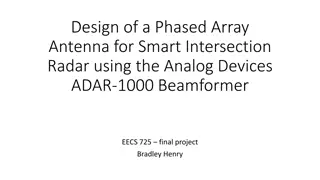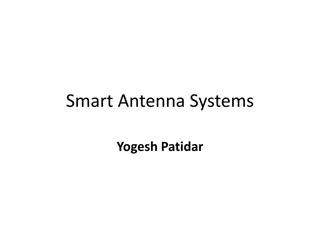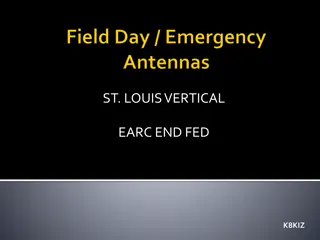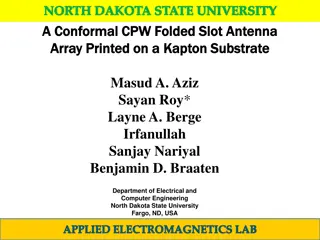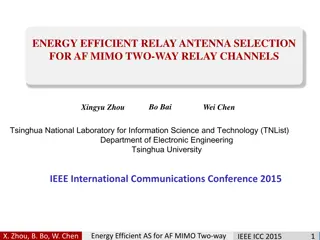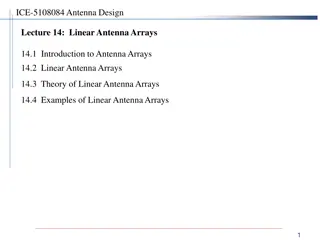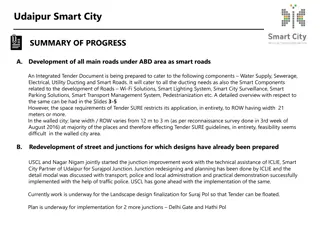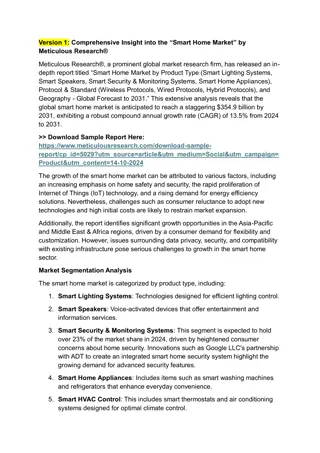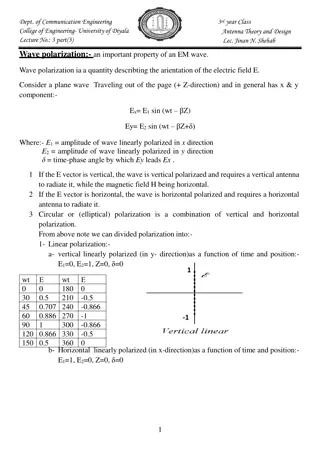
Smart Antenna Systems Overview
Discover the capabilities of smart antenna systems, combining multiple elements with signal processing for optimized radiation and reception. Learn about types, architecture, benefits, and applications of smart antennas for enhanced wireless communication.
Uploaded on | 1 Views
Download Presentation

Please find below an Image/Link to download the presentation.
The content on the website is provided AS IS for your information and personal use only. It may not be sold, licensed, or shared on other websites without obtaining consent from the author. If you encounter any issues during the download, it is possible that the publisher has removed the file from their server.
You are allowed to download the files provided on this website for personal or commercial use, subject to the condition that they are used lawfully. All files are the property of their respective owners.
The content on the website is provided AS IS for your information and personal use only. It may not be sold, licensed, or shared on other websites without obtaining consent from the author.
E N D
Presentation Transcript
www.studymafia.org Seminar On Smart Antenna Submitted To: www.studymafia.org www.studymafia.org Submitted By:
CONTENT Introduction What is Smart Antenna? Types of Smart Antenna systems The goals of a smart antenna system Architecture of smart antenna system Benefits of Switched Beam and Adaptive Array systems Who can use smart antennas ? Advantages of smart antenna Conclusion References
INTRODUCTION A smart antenna system combines multiple antenna elements with a signal processing capability to optimize its radiation and/or reception pattern automatically in response to the signal environment. Beam the radio signal directly at a user to follow the user as they move. 3
What is Smart Antenna? A smart antenna system combines multiple antenna elements with a signal-processing capability to optimize its radiation and/or reception pattern automatically in response to the signal environment. In truth, antennas are not smart antenna systems are smart. Generally co-located with a base station, a smart antenna system combines an antenna array with a digital signal-processing capability to transmit and receive in an adaptive, spatially sensitive manner.
Types of Smart Antenna systems Smart antenna systems are customarily categorized, as either switched beam or adaptive array systems. Switched beam a finite number of fixed, predefined patterns or combining strategies (sectors) Adaptive array an infinite number of patterns (scenario-based) that are adjusted in real time
Switched Beam Antennas It form multiple fixed beams with heightened sensitivity in particular directions. These antenna systems detect signal strength, choose from one of several predetermined, fixed beams, and switch from one beam to another as the mobile moves throughout the sector. switched beam systems combine the outputs of multiple antennas in such a way as to form finely sectorized (directional) beams with more selectivity.
Adaptive Array Antennas Adaptive antenna technology represents the most advanced smart antenna approach by using a variety of new signal-processing algorithms. It provides optimal gain while simultaneously identifying, tracking, and minimizing interfering signals.
The goals of a smart antenna system The purpose of a smart antenna system is to augment the signal quality of the radio- based system through transmission of enhancing capacity frequency reuse. more signals focused while increased radio through The features of a smart antenna system are - signal gain. - inference rejection. -power efficiency.
Architecture of smart antenna system Switched beam and adaptive array systems enable a base station to customize the beams they generate for each remote user effectively by means of internal feedback control. Listening to the cell.(uplink processing). Speaking to the users(downlink processing).
Benefits of Switched Beam and Adaptive Array systems Integration. Range or coverage. Interference suppression.
Who can use smart antennas ? Smart antenna technology can significantly improve wireless system performance and economics for a range of potential users. It enables operators of PCS, cellular, and wireless local loop (WLL) networks to realize significant increases capacity, and coverage. in signal quality,
Advantages of smart antenna Smart antennas can help systems meet these requirements in the following manner: First, both phased and adaptive arrays provide increased power by providing higher gain for the desired signal. In terms of interference suppression, phased arrays reduce the probability of interference with the narrower beam, and adaptive arrays adjust the beam pattern to suppress interference.
Uses of smart antenna Phased arrays are mainly being studied for point-to-point wireless systems, e.g., for wireless local loops. Adaptive arrays are being considered on cellular terminals where local scattering causes wide angular spread. In the TDMA system ANSI-136 adaptive antenna algorithms have been widely deployed.
Conclusion The use of smart antennas is not purely a radio transmission issue. It also influences network services such as handover and connection setup. A smart antenna is a digital wireless communications antenna system that takes advantage of diversity effect at the source (transmitter), (receiver), or both. the destination
REFERENCES www.google.com www.wikipedia.com www.studymafia.org


